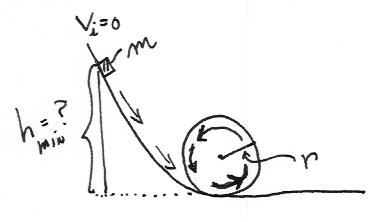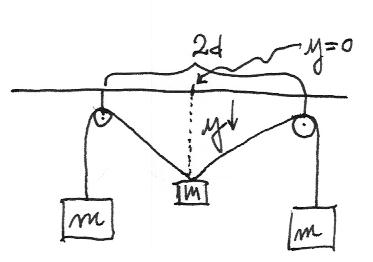4A Homework Set 6:
general energy problems
1. An object is attached to
a vertical spring and slowly lowered to its equilibrium position. This
stretches the spring by an amount d.
If the same object is attached to the same vertical spring but
permitted to fall instead, through what maximum distance does it
stretch the spring?
2. A small block of mass m slides along the frictionless loop-the-loop
track (of radius r) shown in the diagram. What would the minimum height
be such that the block goes all the way around the loop?

3. A point mass m starts from rest and slides down the surface of a
frictionless solid sphere of radius r. Find the angle at which the mass
flies off the sphere.
4. A mass m is dropped from rest above a relaxed spring of stiffness k
a distance D. Find the position from where it was released where the
mass attains its maximum velocity and find that maximum velocity.
5. A mass attached to a string of length L is released from rest from
an initial horizontal
position (although the diagram implies it is not that high, please
ignore that part of the diargram - sorry). From veritcally below where
the string is attached
at its top, there is a peg a distance x below the top attachment of the
string. As the mass swings down to its lowest position, the string then
touches the peg and the mass swings up and around from this new point
(i.e. the peg's position). The mass continues to swing upward. Find the
tension in the string when the mass is at its highest vertical point.

6. Find the potential energy function for the three mass, earth, and
pulley system as shown. The potential enegy will be as a function of
the vertical position downward as shown in the diagram. Also, find the
equlibrium position of this system. The two outside masses are equal.

7. A rope with a length L and total mass M lies coiled on a table. How
much work would it take an applied force to lift the rope completely
off the table at constant speed? At constant kinetic energy?


